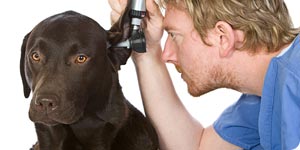
Dog health is a big concern for pet owners.
For those who own dogs with long ear flaps, caring for his ears is very important. That type of dog is prone to ear infections since air cannot circulate inside the ear. Ear infections in dogs are as painful as ear infections in humans. The symptoms presented are very clear and include:
- The infected ear emits a strong odor.
- Exhibiting pain anytime the infected ear is touched or moved.
- Shaking its head more than usual.
- Rubbing the infected ear excessively.
- A yellow or dark discharge.
- The skin on the ear is bright red or may even be bleeding.
These infections will not go away on their own. Any dog with these symptoms should be taken to a veterinarian where a diagnosis can be made:
- The veterinarian will examine the ear canal with an otoscope.
- The veterinarian will then take a sample of any discharge for cytology and culturing.
- There are three types of ear infections; diagnosing these requires a culture of the discharge found inside the ear. These types are:
- Yeast infection
- Bacterial infection
- Fungus infection
After the veterinarian has examined the ear and it has been determined that a specific infection is present, treatment can begin:
- Use an ear-cleaning solution to clean the infected ear. Never use water or peroxide. Hold the earflap and pour the solution into the ear, filling the canal. Massage the canal gently to work the debris loose. Take a tissue and wipe the canal as deeply as you can reach with your finger. Repeat the procedure until no wax or debris is on the tissue and the dog ears appear to be clean.
- The vet may have to anesthetize the dog and clean the ear if he is in pain, or to remove a tick or foreign body.
- The vet may also prescribe antibiotics or an antifungal agent to put in the ear, depending on the type of infection that was found.
Infections usually take 3 to 6 weeks to clear up with treatment, including cleaning the ear twice daily. If this condition goes untreated, it can lead to surgery due to complications such as an infection that penetrates the ear drum or a canal that has closed.
It is important to be proactive and prevent further infections. To prevent them, you should:
- Clean the ears weekly.
- Clean the ears after each swim.
- Remove hair from the ears if the dog has a lot growing in them.
Canine ear infections are usually caused by:
- Water left in the ear after swimming.
- A thyroid condition.
- Allergies.
- Parasites.
- A foreign body in the ear.
- A tumor in the ear.
